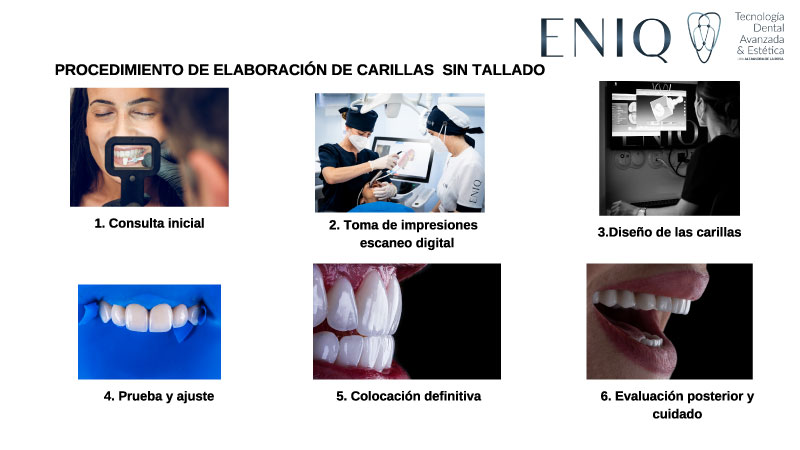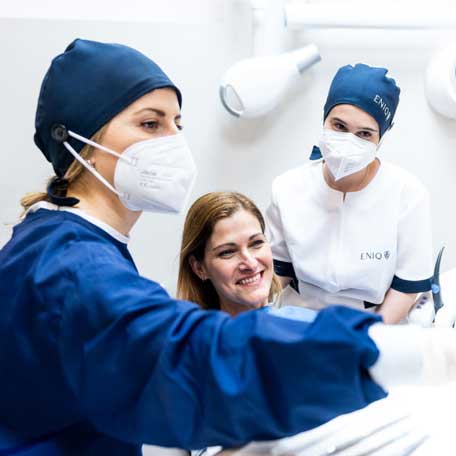

No-Prep Veneers
Discover the revolution in dental aesthetics with veneers without trimming.
What are Non Prep or No Trimming Dental Veneers?
No trimming dental veneers, also known as non prep veneers or no preparation veneers, are a type of dental veneers that are placed over the teeth without the need for significant trimming or wearing down of the natural dental structure. Unlike traditional veneers, which require the removal of a layer of dental enamel to make space for the veneers, no trimming dental veneers adhere directly to the tooth surface without altering its shape or size.
No trimming dental veneers are generally thinner than traditional veneers, allowing them to adhere directly to the existing dental enamel. They are made from materials such as composite or ultra-thin ceramic, providing a natural and aesthetic appearance.
Some advantages of no trimming dental veneers include:
- Conservation of natural dental structure: As no significant dental trimming is required, more natural dental enamel is preserved compared to traditional veneers.
- Faster and less invasive process: The placement process for no trimming dental veneers is faster and less invasive.
- Reversibility: Since no permanent dental trimming is performed, no trimming dental veneers are potentially reversible.
However, it is important to note that no trimming dental veneers are not suitable for all cases and may be less suitable in certain situations.
As always, it is advisable to consult with a qualified and experienced dentist to determine if no trimming dental veneers are the right option for your specific dental situation.
What is the Process of Making Non Prep or No Trimming Dental Veneers?
The process of making non prep or no preparation veneers usually involves the following steps:
- Initial consultation: The process begins with an initial consultation with your dentist. During this visit, you will discuss your aesthetic goals and your oral health will be evaluated to determine if you are a good candidate for no preparation veneers.
- Impressions or digital scanning: If you are determined to be a good candidate, impressions of your teeth will be taken or a digital scan of your mouth will be performed. This is done to create a three-dimensional model of your teeth, which will be used as a reference for the fabrication of the veneers.
- Veneer design: Using the model of your teeth, the veneers will be designed. This can be done manually or using computer-aided design (CAD) technology for optimal precision in the shape and size of the veneers.
- Veneer fabrication: Once the design is finalized, the veneers will be fabricated using the selected material, either composite or ceramic. Depending on the type of veneer and the dental laboratory used, the manufacturing process can vary. In some cases, computerized milling machines (CNC) are used to precisely sculpt the veneers.
- Trial and adjustment: Once the veneers are fabricated, an appointment will be scheduled for trial and adjustment. During this visit, your dentist will temporarily place the veneers on your teeth to check the fit, shape, and color. Minor adjustments can be made in the dental office to ensure an aesthetic and comfortable result.
- Final placement: After trial and adjustment, the veneers will be definitively placed on your teeth. Before placement, your teeth will be cleaned and prepared to ensure proper adhesion of the veneers. Special dental adhesives will be used and a special light will be applied to harden the material and fix the veneers in place.
- Post-placement evaluation and care: After placement, your dentist will re-evaluate the result and provide instructions on how to properly care for your veneers. It is important to follow oral care recommendations, such as brushing and flossing regularly, as well as attending regular dental check-ups.
It is important to note that the specific process may vary depending on each case and the dentist's preferences. It is important to communicate with your dentist to get accurate and detailed information about the process of making non prep or no preparation or trimming dental veneers in your specific case.

Duration
How many visits are required for a veneer treatment?
The placement of no preparation dental veneers generally requires fewer appointments compared to traditional dental trimming veneers. The exact number of appointments may vary depending on the individual case and specific circumstances, but in general, the process of placing no preparation dental veneers can involve around 2 to 3 appointments.

These are the typical appointments involved in placing no preparation dental veneers:
-
Initial consultation
During this initial appointment, you will meet with your dentist to discuss your aesthetic goals, assess oral health, and determine if you are a suitable candidate for no preparation dental veneers. During this visit, impressions of your teeth or a digital scan may also be taken to create a three-dimensional model of your mouth.
-
Trial and adjustment
In the next appointment, your dentist will temporarily place the no preparation veneers on your teeth to check the fit, shape, and color. Minor adjustments can be made in the dental office to achieve the desired aesthetic result. This stage is crucial to ensure that the veneers fit your teeth correctly and achieve the desired look.
-
Final placement
In the last appointment, the no preparation veneers will be definitively placed on your teeth. Before placement, your teeth will be cleaned and properly prepared to ensure proper adhesion. Special dental adhesives will be used, and a special light will be applied to harden the material and fix the veneers in place.
It is important to note that these are only general examples and the actual number of appointments may vary depending on the case and the dentist's preferences. Some cases may require additional appointments to achieve the best aesthetic results and ensure patient satisfaction.
We recommend discussing the specific number of appointments and treatment plan with your dentist, as they will be able to provide you with more accurate and detailed information based on your individual dental case.

Which is better: veneers with dental trimming or without?
The choice between veneers with dental trimming and no trimming dental veneers depends on various factors, including your individual needs and preferences, as well as the dentist's recommendations. Both approaches have their own advantages and considerations to take into account:
Veneers with Dental Trimming
- Flexibility of Correction: Veneers with dental trimming allow for greater flexibility in aesthetic correction of the teeth. By removing a thin layer of dental enamel, it's possible to adjust the shape, size, and position of the teeth more significantly, allowing for a customized aesthetic result.
- Predictable Results: Due to the greater degree of control in tooth preparation, veneers with dental trimming offer more predictable results in terms of appearance, aesthetics, and dental alignment.
- Greater Long-term Durability: By allowing adequate dental trimming, veneers with trimming can offer a larger surface area for bonding, resulting in a more solid and durable union with the teeth, which can lead to an extended lifespan.
No Trimming Dental Veneers
- Preservation of Natural Dental Structure: No trimming dental veneers require minimal or no removal of natural dental enamel, preserving the original dental structure. This can be especially beneficial for patients with healthy teeth who want a less invasive option.
- Faster and Less Invasive Process: As no dental trimming is required, the procedure for placing no trimming dental veneers is faster and less invasive. This can result in a more comfortable experience and reduce the risk of postoperative dental sensitivity.
- Potentially Reversible: Since there is no permanent trimming of the teeth, no trimming dental veneers can be potentially reversible, meaning they can be removed or replaced in the future if necessary.
It is important to note that the choice between veneers with dental trimming and no trimming dental veneers depends on your specific dental needs, as well as the evaluation and recommendation of your dentist. It is advisable to discuss your goals, concerns, and expectations with your dentist to make an informed decision and determine which of these options is most suitable for your individual case.
What are the disadvantages of no preparation veneers?
While no preparation or no trimming dental veneers can offer certain advantages, they also present some disadvantages that are important to consider.
Disadvantages
- Limited Thickness: No preparation veneers are usually thinner than traditional veneers, which means there is a limit to the amount of aesthetic correction that can be achieved. In some cases, it may be difficult to hide stains, discolorations, or severe irregularities in the teeth with no preparation veneers.
- Limitations in Shape and Size Change: Since no preparation veneers do not involve significant dental trimming, they do not allow for major changes in the shape and size of the teeth. If more pronounced correction in these aspects is required, other options such as traditional veneers or orthodontic treatments may need to be considered.
- Higher Risk of Artificial Appearance: Due to the limited thickness of no preparation veneers, it may be more challenging to achieve a completely natural and translucent appearance compared to traditional veneers. In some cases, no preparation veneers may result in a more opaque or less aesthetic look.
- Dental Sensitivity: As there is no prior dental trimming, some patients may experience increased dental sensitivity after the placement of no preparation veneers. This is because the layer of dental enamel remains intact and there may be less protection against external stimuli.
- Limited Reversibility: Although no preparation veneers are considered potentially reversible, in some cases there may be difficulties in removing them without causing damage or wear to the dental enamel. Therefore, it is important to consider that the reversal process may not be as straightforward as with traditional veneers.
It is important to note that these disadvantages can vary depending on the individual case and the specific characteristics of the teeth and oral health. It is important to discuss your concerns and expectations with your dentist to determine if no preparation veneers are the right option for you, or if other alternatives need to be considered.
+90%
What is the success rate with the micro-screw technique?
No preparation dental veneers can be a good option for improving dental aesthetics. However, it's important to note that the success rate of this treatment can vary depending on various factors, such as the dentist's skill, the quality of the material used, the proper selection of the patient, and subsequent oral care.
Generally, no preparation dental veneers are considered to have a high success rate when performed correctly. If the veneers are placed properly and maintained with proper oral care, they are expected to have a long lifespan and durable aesthetic appearance.
However, it's important to remember that each case is unique and results can vary from one patient to another. Therefore, it's recommended to consult with a qualified dentist before making a decision.
EnIQ: Innovative Technology for No Trimming Dental Veneers
EnIQ is an innovative technology used in the placement of no trimming dental veneers. Some of the potential benefits of performing no trimming dental veneers with EnIQ technology may include:
- Conservation of Dental Structure: No trimming dental veneers with EnIQ allow for the preservation of your teeth's natural structure, as there is no need to remove a layer of dental enamel to place the veneers. This is especially beneficial if you have healthy teeth and do not wish to undergo irreversible trimming.
- Faster Process: EnIQ technology can speed up the process of placing no trimming dental veneers, meaning you could achieve improved aesthetic results in less time. The veneers are designed and fabricated with precision using computerized technology, which reduces the time needed to create custom veneers.
- Aesthetic Customization: With EnIQ, no trimming dental veneers are designed and fabricated precisely to fit your teeth and your individual aesthetic needs. This allows for highly personalized and natural results, improving the appearance of your teeth and smile.
- Reduced Dental Sensitivity: By preserving the natural dental structure, no trimming dental veneers with EnIQ can reduce the risk of postoperative dental sensitivity compared to veneers that require prior dental trimming.
- Durable Aesthetic Results: No trimming dental veneers fabricated with EnIQ technology are usually durable and stain-resistant. The materials used, such as lithium disilicate, can offer excellent aesthetics and increased resistance to discoloration over the long term.
It is important to note that these benefits are general and may vary depending on the individual case and specific circumstances. If you are interested in no trimming dental veneers with EnIQ technology, I would recommend seeking a dentist experienced in its use and discussing your aesthetic expectations and goals with them. The dentist will be able to assess your case and determine if no trimming dental veneers with EnIQ are the right option for you.
Price of No Trimming Dental Veneers
Both the material and the number of veneers a person needs are determinants in the price, and this is determined by doing a detailed study of the case using design programs.
However, as a guideline, we can say that the price of the veneers usually ranges between 250 and 500 euros per piece.
At ENIQ, we recommend that you do these types of veneers in ceramic with composite. For disilicate, there is almost always a need to trim interproximally at least 0.2 mm so that the veneer adapts and does not fracture.
Dental Veneers
No Trimming
*subject to specialist evaluation
The price of the veneers varies depending on the number of veneers needed and other factors, with 250 to 500€ being a good starting point per piece.
-
All-inclusive
Frequently Asked Questions
Do you have more questions about no trimming or Non Prep dental veneers?
- People who want to improve the aesthetics of their teeth without filing dental enamel.
- People with teeth that have stains, mild discolorations, or irregularities.
- People with a limited budget.
No trimming dental veneers can last between 5 and 10 years, depending on the care they receive. It's important to brush your teeth twice a day, use dental floss daily, and regularly attend dental check-ups.
Yes, no trimming dental veneers can be removed. The removal procedure is usually carried out in one visit to the dentist. The dentist will use a special tool to detach the veneers from the teeth.
If a no trimming dental veneer breaks, it is important to visit the dentist as soon as possible. The dentist can repair or replace the veneer.
